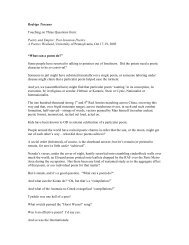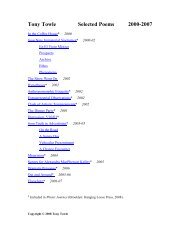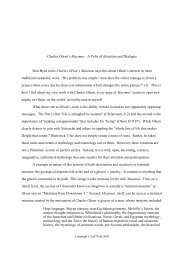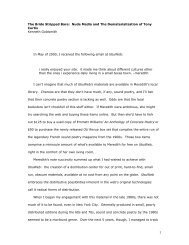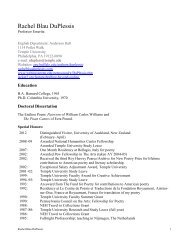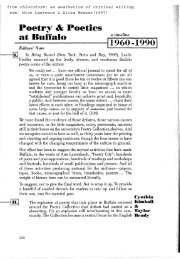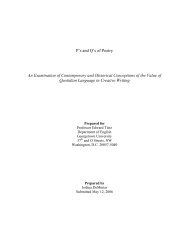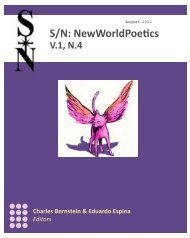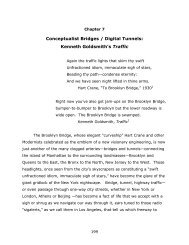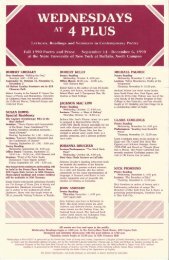Preface - Electronic Poetry Center
Preface - Electronic Poetry Center
Preface - Electronic Poetry Center
You also want an ePaper? Increase the reach of your titles
YUMPU automatically turns print PDFs into web optimized ePapers that Google loves.
For one thing, business itself is not treated in such a sink-or-swim way:<br />
government subsidies are an integral part of many industries, from farming to<br />
sports franchises. One of the better reasons for such subsidies is that they shield<br />
enterprises from momentary reverses. If farmers couldn’t survive a single bad<br />
season, it would ultimately make for a weak social fabric. With the arts, the<br />
time frame is often more stretched out. It can easily take decades for general<br />
taste to approve of developments in art. The last hundred years are full of<br />
examples. In France painters such as Monet and Matisse were ridiculed by the<br />
majority of their contemporaries; there was a riot at the premier of Stravinski’s<br />
"Rites of Spring." Of course, paintings by Monet and Matisse are now among<br />
the most valuable objects on the planet; and thirty years after it had driven<br />
listeners into a frenzy of disgust, Stravinski’s music was used by Disney as the<br />
soundtrack to the dinosaur section of "Fantasia."<br />
These are examples of successes. But it’s not always the case that today’s<br />
innovative art becomes tomorrow’s classic. A 1920’s symphony by George<br />
Antheil that used airplane engines has not yet become a cultural treasure (nor is<br />
it likely to). That’s important. It misses the point to say "Fine, innovate, be<br />
creative. But only if you turn out to be Monet. No duds or wild excesses,<br />
please."<br />
But why should the government have to underwrite art? Didn’t Monet work on<br />
his own? There are a couple of answers to this. For one thing, a significant part<br />
of NEA money goes to community groups, often helping get art to groups and<br />
places it doesn’t normally reach: smaller towns, rural areas, schools that don’t<br />
have the resources for art programs. And for the government to cut all arts<br />
funding would mean that it recognizes no values other than the marketplace.<br />
Under the reign of purely economic motives, there is no way anyone would<br />
want to produce something unless it could be sold immediately. Imagine a<br />
society in which every cultural product had to turn a profit instantly. If you<br />
want to get a sense of how claustrophobic this can be, consider how dominated<br />
commercial television is by spinoffs and imitations.<br />
Given how informative, exciting, and revealing the arts can be, what an<br />
important antidote they are to instant opinion polls, and how important they<br />
already are to various different parts of the community, I think they’re worth 65<br />
cents a year. The money is not wasted: people in the arts are appreciative of the<br />
little support they get and work hard whether or not they get it. By their very<br />
nature, the arts speak to the individual’s judgment at the same time as they<br />
offer possibilities for building communities: they’re perfect training for the





